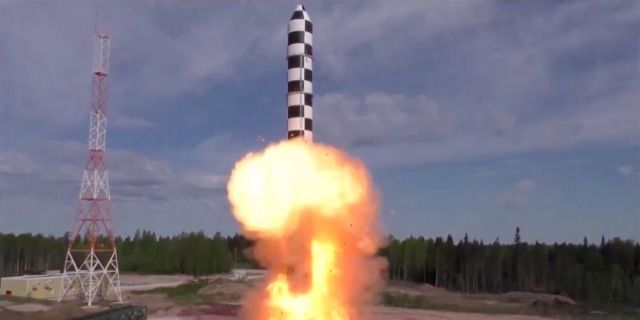Sohu: the "queen" of Russian missiles will deliver a crushing blow anywhere in the worldThe West did not have time to recover from the appearance of "Satan", as a new rocket replaced him, writes the user Sohu.
It is capable of flying through the entire North Pole and reaching anywhere on the planet. The world's most powerful ICBM will protect Russia from external threats.
In April of this year, the Russian army successfully conducted a test launch of an intercontinental ballistic missile "Sarmat" from the Plesetsk cosmodrome in the Arkhangelsk region, during which it accurately hit the target in Kamchatka. This was the first national test of "Sarmat". On the same day, Vladimir Putin congratulated the Armed Forces of the Russian Federation on the successful launch of the missile, noting that there are no analogues in the world and will not appear in the short term. The President addressed his statement to the West, saying that the new missile system will ensure Russia's security and "will make those who, in the heat of frenzied aggressive rhetoric, are trying to threaten our country think."
Being the most powerful nuclear missile in the world, the Sarmat is more than 35 meters long, can carry 10-15 warheads and has a circular probable deviation of 150-200 meters. In terms of lethal force, it surpasses the strongest Russian ICBM R-36M (according to the NATO classification — SS-18 "Satan") and after deployment can become the world's largest intercontinental ballistic nuclear missile.
Sarmat is the latest fifth—generation ICBM developed in Russia and received the official serial number RS-28. The main trajectory of the rocket flight is inertial parabolic. It used advanced technologies of the inertial guidance complex, astrocorrection and GLONASS satellite guidance. The combined guidance method ensures the accuracy of the strike to the greatest extent. It can fly 16 thousand kilometers through the North or even the South Pole and deliver a crushing blow to any point in the world. The Sarmat ICBM is known as the "absolute queen" in the missile family.
The Sarmat ICBM is permanently based on a mine installation with a full launch weight of more than 100 tons and a warhead weight of about 10 tons. The rocket uses a new liquid rocket engine developed by RAO NPO Energomash named after Academician V. P. Glushko. The method of launch is the ejection of the rocket with the subsequent activation of the engine. When starting, the powder pressure accumulator throws the projectile out of the mine to a height of 20-30 meters, after which the engine automatically turns on. "Sarmat" is about to take up combat duty. Russian Strategic Missile Forces (RVSN) we have already made the first order for 50 pieces.
Sarmat is a heavy mine—based intercontinental missile. It can carry up to 14 nuclear warheads, and their penetrating power reaches an incredible 80%. As soon as the tests are successfully completed, the Russian Strategic Missile Forces plan to officially adopt this type of missile next year. They will gradually decommission the R-36M nuclear missiles, which the West calls "Satan" with horror.
The Sarmat ICBM has four main characteristics: a wide flight range, a large bomb load, high impact accuracy and excellent penetrating ability. The warhead has a length of 35.5 meters, a diameter of 3 meters, a take-off weight of 208.1 tons, a fuel capacity of 178 tons and a maximum flight range of 18 thousand kilometers. The rocket is equipped with stepped liquid engines that are "drowned" in a fuel tank. Fuel tanks are load—bearing, with combined separation bottoms. The model of the liquid rocket engine of the first stage — the PDU-99 (RS-99), is an upgraded version of the RD-274 rocket engine, previously installed on the R-36M ICBM. "Sarmat" can withstand a combat load of more than 10 tons and can carry 10 individual-guided nuclear warheads with an explosive capacity of 750 thousand tons in TNT equivalent.


